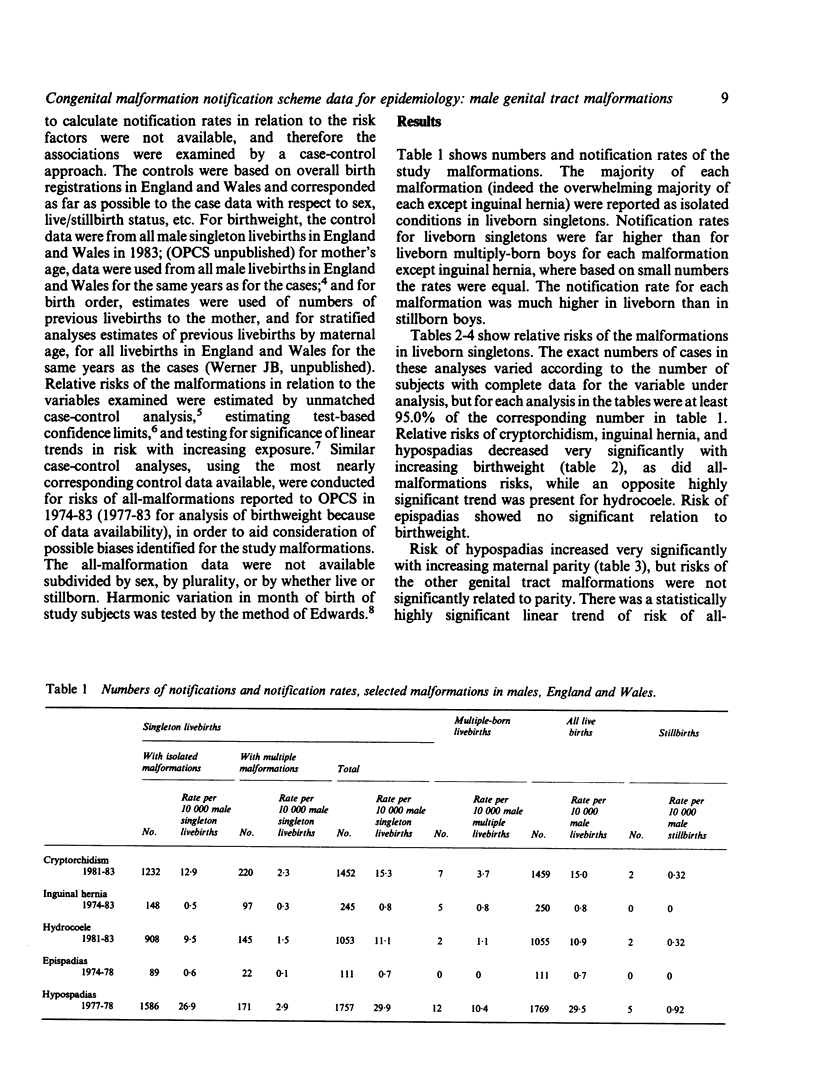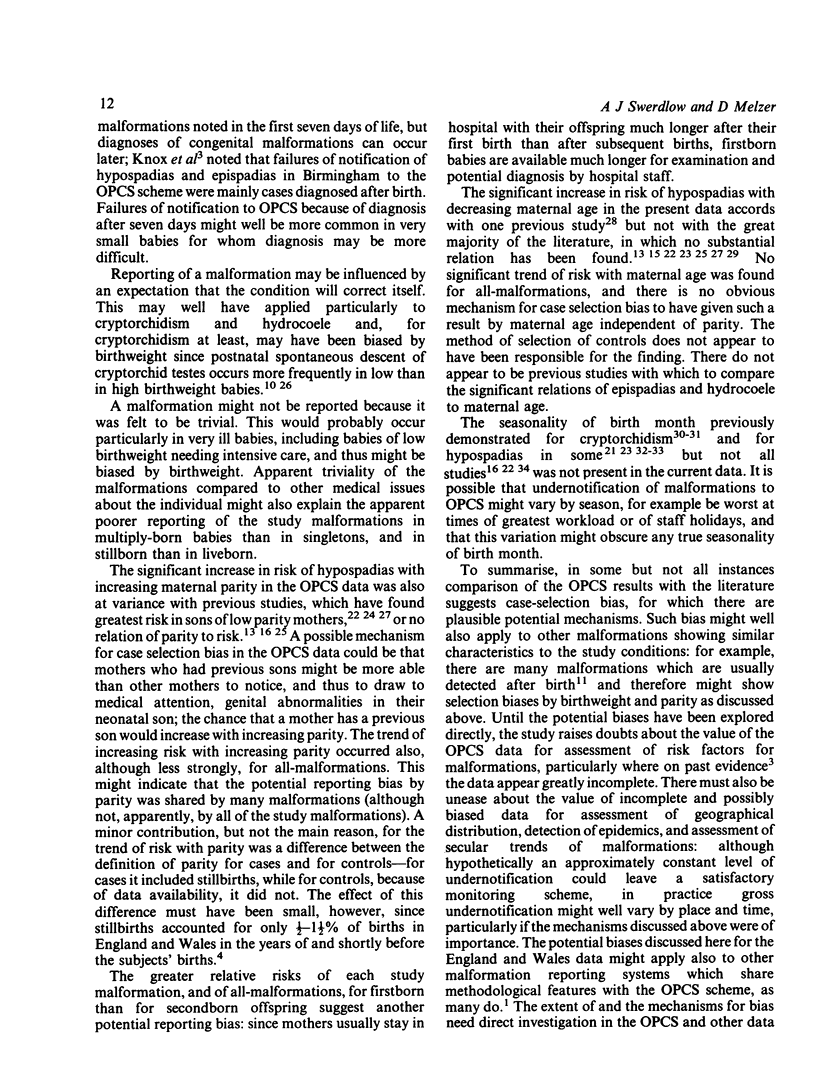Abstract
Data from the England and Wales national congenital malformation notification scheme were examined for associations of male genital tract malformations. For some of the malformations comparison of notification rates with the literature suggested gross undernotification. There was also evidence suggesting bias: examination of the relationships of the malformations to birth weight, maternal parity, and maternal age at delivery showed some highly significant trends in risk, most of which were at variance with findings in the literature, and several potential mechanisms for bias could be adduced. Direct investigation is needed, for this and other similar data sets, of the extent and mechanisms of biased undernotification.
Full text
PDF





Selected References
These references are in PubMed. This may not be the complete list of references from this article.
- Aarskog D. Clinical and cytogenetic studies in hypospadias. Acta Paediatr Scand Suppl. 1970;203(Suppl):1+–1+. [PubMed] [Google Scholar]
- Avellán L. On aetiological factors in hypospadias. Scand J Plast Reconstr Surg. 1977;11(2):115–123. doi: 10.3109/02844317709025507. [DOI] [PubMed] [Google Scholar]
- BUEMANN B., HENRIKSEN H., VILLUMSEN A. L., WESTH A., ZACHAU-CHRISTIANSEN B. Incidence of undescended testis in the newborn. Acta Chir Scand Suppl. 1961;Suppl 283:289–293. [PubMed] [Google Scholar]
- Baird P. A. Incidence of hypospadias. Lancet. 1985 May 18;1(8438):1162–1162. doi: 10.1016/s0140-6736(85)92468-7. [DOI] [PubMed] [Google Scholar]
- Chen Y. C., Woolley P. V., Jr Genetic studies on hypospadias in males. J Med Genet. 1971 Jun;8(2):153–159. doi: 10.1136/jmg.8.2.153. [DOI] [PMC free article] [PubMed] [Google Scholar]
- Czeizel A. Epidemiologic characteristics of congenital inguinal hernia. Helv Paediatr Acta. 1980 Mar;35(1):57–67. [PubMed] [Google Scholar]
- Czeizel A., Erödi E., Tóth J. An epidemiological study on undescended testis. J Urol. 1981 Oct;126(4):524–527. doi: 10.1016/s0022-5347(17)54609-1. [DOI] [PubMed] [Google Scholar]
- Depue R. H. Maternal and gestational factors affecting the risk of cryptorchidism and inguinal hernia. Int J Epidemiol. 1984 Sep;13(3):311–318. doi: 10.1093/ije/13.3.311. [DOI] [PubMed] [Google Scholar]
- EDWARDS J. H. The recognition and estimation of cyclic trends. Ann Hum Genet. 1961 May;25:83–87. doi: 10.1111/j.1469-1809.1961.tb01501.x. [DOI] [PubMed] [Google Scholar]
- Hay S., Barbano H. Independent effects of maternal age and birth order on the incidence of selected congenital malformations. Teratology. 1972 Dec;6(3):271–279. doi: 10.1002/tera.1420060304. [DOI] [PubMed] [Google Scholar]
- Jackson M. B., Swerdlow A. J. Seasonal variations in cryptorchidism. J Epidemiol Community Health. 1986 Sep;40(3):210–213. doi: 10.1136/jech.40.3.210. [DOI] [PMC free article] [PubMed] [Google Scholar]
- KNOX G. The incidence of inguinal hernia in Newcastle children. Arch Dis Child. 1959 Dec;34:482–486. doi: 10.1136/adc.34.178.482. [DOI] [PMC free article] [PubMed] [Google Scholar]
- Knox E. G., Armstrong E. H., Lancashire R. The quality of notification of congenital malformations. J Epidemiol Community Health. 1984 Dec;38(4):296–305. doi: 10.1136/jech.38.4.296. [DOI] [PMC free article] [PubMed] [Google Scholar]
- Källén B., Winberg J. An epidemiological study of hypospadias in Sweden. Acta Paediatr Scand Suppl. 1982;293:1–21. doi: 10.1111/j.1651-2227.1982.tb09577.x. [DOI] [PubMed] [Google Scholar]
- MANTEL N., HAENSZEL W. Statistical aspects of the analysis of data from retrospective studies of disease. J Natl Cancer Inst. 1959 Apr;22(4):719–748. [PubMed] [Google Scholar]
- Miettinen O. Estimability and estimation in case-referent studies. Am J Epidemiol. 1976 Feb;103(2):226–235. doi: 10.1093/oxfordjournals.aje.a112220. [DOI] [PubMed] [Google Scholar]
- ROSS J. F., FARMER A. W., LINDSAY W. K. Hypospadias: a review of 230 cases. Plast Reconstr Surg Transplant Bull. 1959 Oct;24:357–368. doi: 10.1097/00006534-195910000-00006. [DOI] [PubMed] [Google Scholar]
- Roberts C. J., Lloyd S. Observations on the epidemiology of simple hypospadias. Br Med J. 1973 Mar 31;1(5856):768–770. doi: 10.1136/bmj.1.5856.768. [DOI] [PMC free article] [PubMed] [Google Scholar]
- SCORER C. G. THE DESCENT OF THE TESTIS. Arch Dis Child. 1964 Dec;39:605–609. doi: 10.1136/adc.39.208.605. [DOI] [PMC free article] [PubMed] [Google Scholar]
- Simpkin J. M., Owens J. R., Harris F. Incidence of hypospadias. Lancet. 1985 Aug 17;2(8451):384–384. doi: 10.1016/s0140-6736(85)92513-9. [DOI] [PubMed] [Google Scholar]
- Svensson J. Male hypospadias, 625 cases, associated malformations and possible etiological factors. Acta Paediatr Scand. 1979 Jul;68(4):587–592. doi: 10.1111/j.1651-2227.1979.tb05060.x. [DOI] [PubMed] [Google Scholar]
- Theander G. Seasonal distribution of births of boys with anomalies of the urethra. Scand J Urol Nephrol. 1970;4(1):1–5. doi: 10.3109/00365597009136222. [DOI] [PubMed] [Google Scholar]
- Villumsen A. L., Zachau-Christiansen B. Spontaneous alterations in position of the testes. Arch Dis Child. 1966 Apr;41(216):198–200. doi: 10.1136/adc.41.216.198. [DOI] [PMC free article] [PubMed] [Google Scholar]
- Wehrung D. A., Hay S. A study of seasonal incidence of congenital malformations in the United States. Br J Prev Soc Med. 1970 Feb;24(1):24–32. doi: 10.1136/jech.24.1.24. [DOI] [PMC free article] [PubMed] [Google Scholar]


